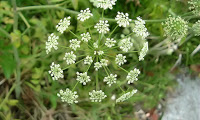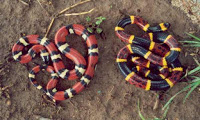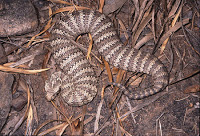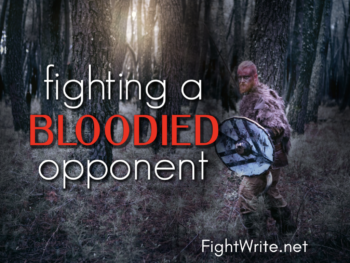If you are joining the show late, our first installment on poisoning explained some of the medical jargon you will encounter here. Part two covered various types of poison and their effects. In this, our third and final round on poisoning, we are going looking at flora and fauna. Now, there’s a ton of poisonous plants and animals out there. Books have been written on them. I couldn’t cover them all but here’s a few.
Belladonna – Also know as deadly nightshade, belladonna impacts the nervous system causing dry
 |
| Belladonna |
mouth, enlarged pupils, blurred vision, fever, tachycardia, inability to urinate, sweating, hallucinations, spasms, seizures and coma. Both the berries and leaves are poisonous. It is purported that as few as two berries can kill a child and ten to twenty can kill an adult.
 |
| Oleander |
Oleander – I looked through dozens of sites including the CDC and couldn’t find an exact time on how quickly oleander affects the body. However, I often saw that medical attention must be expedient and includes gastric lavage. All parts of the oleander plant are poisonous even the smoke resulting from its burning. Symptoms of oleander poisoning are sweating, vomiting, bloody diarrhea, unconsciousness, respiratory paralysis, and, finally, death.
Rosary Pea – Abrin is the poison in the rosary pea. Exposure can be the result of inhalation, ingestion
 |
| Rosary Pea |
or contact with the skin or eyes. Death from abrin poisoning could occur thirty-six to seventy-two hours after exposure.
Symptoms of inhalation include respiratory distress, fever, cough, nausea, heavy sweating and pulmonary edema. The build up of fluid in the lungs could cause cyanosis. Finally, low blood pressure and respiratory failure could occur.
Symptoms of ingestion are vomiting, bloody diarrhea (is there a grosser two word phrase? mercy!), severe dehydration and low blood pressure. Other possible symptoms may include hallucinations, seizures, and blood in the urine. Within several days, failure of the liver, spleen, and kidneys may occur. poisonous plants
 |
| Water hemlock |
Water Hemlock – Water hemlock is dangerous to ingest or even apply to the skin. All parts of the plant are considered dangerous and can cause death in under twenty minutes. It is said that Socrates was sentenced to death by means of drinking hemlock. Symptoms of water hemlock poisoning are drooling, nausea, vomiting, difficulty breathing, sweating, dizziness, abdominal pain, weakness, delirium, diarrhea, convulsions, heart problems, kidney failure and coma.
Poisonous Snakes
Y’all, snakes are weapons. If the setting of your manuscript is rural or an area known for snakes, make use of them! Here are a few of the most poisonous snakes and the effects of their venom. Treatment of all bites by poisonous snakes should include professional medical care. One should never put ice on a bite or apply a tourniquet to a bitten limb. Also, an incision should not be made to the wound as it could cause further injury. And, I might as well say it: don’t try to suck out the venom! I mean, really?
Here’s a video on snake bites that just makes me happy. I don’t know why they called an ambulance. The awesomeness and raw confidence of that second guy should have been enough to make the snake venom leave the body out of respect! poisonous plants
 |
| Corn and Coral Snakes |
Coral snakes look a lot like corn snakes. The latter, however, is harmless. There’s a rhyme that helps you identify the poisonous from the harmless and refers to the snake’s coloration. “Red on black won’t hurt Jack. Red on yellow will kill a fellow!”
 |
| Death Adder |
way to go. Death adder venom can cause a loss of voluntary muscle control which can result in respiratory failure. Other symptoms of death adder envenomation include abdominal pain, headache, drowsiness and inability to control eye movement.
 |
| Western Diamondback |
The effects of a rattlesnake bite begin quickly, within seconds of being bitten. Medical help should be reached within thirty minutes of being struck. If left untreated, effects of the venom will increase within a period of two to three days and result in organ failure and death. Symptoms of a rattlesnake bite include sweating, numbness in the face or limbs, lightheadedness, excessive salivation, weakness, nausea, vomiting, blurred vision and difficulty breathing.
Well, that’s it for our series on poison. What’s the next round about? Well, that’s up to you. Let me hear from you on “the Twitter” @carlahoch #fightwrite
Until the next round at FightWrite.net, get blood on your pages!











"Y'all, snakes are weapons." I just heard my character, who just confessed a few days ago to having a fear of snakes, who knows he's eventually going to be put up against a nightmare "oh heck no" venomous snake, give a groan of despair at that one asdfghjkl. Funny timing though because I was actually just researching snakes– and learned about the blue coral snake, which is honestly a lot more terrifying than I expected it to be!
I didn't expect to find out more about snakes here though fhghghg I actually came for the plant poisons, because I guess having one source of toxin in my story isn't gonna be good enough xD In any case this is a wonderful resource that I'll definitely be hanging onto for when I get to that point of the story. Thanks for the great article– and honestly articles because I've been reading through a lot of them and they're all fantastic!